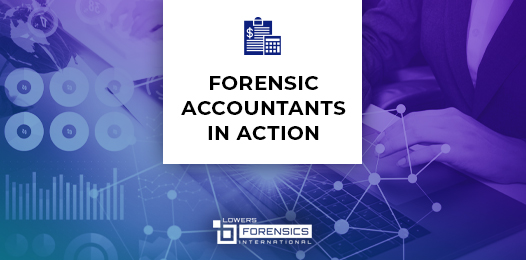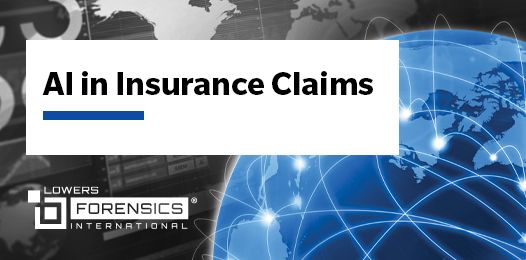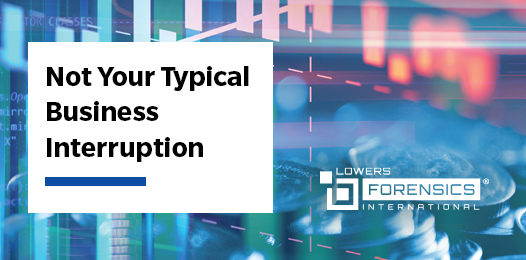Forensic accountants apply accounting, investigation, and interpretation of documents to quantify financial data, form conclusions and provide findings “suitable for court.” Their services are sought by insurance companies, attorneys, businesses, and other organizations seeking to transform complex financial information into accurate, concise information and if needed, compelling evidence.
We spoke with Danielle Gardiner, CPA, CFF of Lowers Forensics International to understand some of the situations where forensic accountants are called into action. Here are five common scenarios:
1. Mergers & Acquisitions Due Diligence
The role of a forensic accountant in mergers and acquisitions (M&A) is to validate and confirm that the financial information being presented – usually by the company to be acquired – is accurate and meaningful. In more blunt terms, forensic accountants provide peace of mind to the entities involved in M&As so they don’t experience any “surprises” after the deal closes.
When performing due diligence, we ask a lot of questions about the company’s financials. For example, if the seller represents that they have $1 million in accounts receivable, we ask ‘How old are those receivables?’ If they’re over 90 days, they probably shouldn’t be included in the receivables or at least should be discounted to some degree.
Forensic accountants also test the veracity of the records they are asked to examine. In the case of accounts receivables, this might mean tracking down a specific purchase, finding the transaction in a POS system, or even calling a customer to confirm the purchase.
Another function these accountants perform in M&As, is determining the valuation of the business to be acquired. This can be accomplished using a range of formulas, from financial ratios (e.g., asset to liability ratio), fair market value, or on an earnings multiple basis.
In other cases, forensic accountants are hired by insurance companies to make sure that the insured party they represent is accurately depicting their financial claims. There is a line of coverage called Reps and Warranties which indemnifies either purchasers or sellers (depending on the type of contract) from unforeseen costs caused by any breaches of the parties’ financial representations. If a seller claims to have inventory worth $2 million and later the actual value is only found to be $1,250,000, there would be a $750,000 claim about the representation.
2. Fraud Investigations
When employee malfeasance (e.g., theft, forgery, fraud) happens at the workplace, employers will often submit a damage claim to their insurance provider under their fidelity insurance policy. The insurance company, in turn, will engage the services of a forensic accountant to validate whether the fraud actually occurred based on the books and records and to investigate the financial impact.
“One of the first things I do is ask for personnel records and substantiate that the policyholder has a W2 on file for the employee in question,” says Danielle Gardiner. “Fidelity insurance normally only covers employees, not people under contract or other third parties documented by a 1099.”
Depending on the nature of the fraud, Gardiner says she then begins looking into the books and financial records of the company. She describes one highly unusual case in which a relatively new bookkeeper was suspected of misappropriating funds. “When I investigated their accounts, I found a defunct account that the company no longer used but that had never been closed out. It turns out the bookkeeper had been mistakenly and unknowingly making deposits into the defunct bank account. The monies were in the possession of the company the entire time, and they just didn’t know it!”
More commonly, Gardiner says she is able to identify the methods by which the employee perpetrated the fraud. “There have been times where a bookkeeper will set up a fictitious employee in the payroll system and begin issuing checks to themselves or a family member in order to divert funds,” she notes.
In other cases, the person paying the bills might notice that they use the same vendor for their electrical utilities as the company and start paying their personal electric bill through the company. “These cases tend to happen in offices where there is no separation of duties. The person paying the bills is also making deposits, approving invoices, and managing budgets,” Gardiner explains.
3. Property Theft
Similar to fidelity cases, insurance companies tend to reach out to forensic accountants in conjunction with an insured’s property theft claim. Unlike fidelity claims, however, commercial property theft claims generally involve bad actors from outside the company, for example, someone breaking in through a roof. “Usually, criminals are looking for cash, but they might take electronics or other goods if they think they can sell them easily on the street,” says Gardiner.
While it may seem straightforward to calculate the value of stolen property, there are many variables that forensic accountants consider in order to reach a fair valuation. In one case, a company had an extensive amount of inventory stolen and it took two full weeks for the business to restore the missing inventory.
In other scenarios, the stolen inventory may have been at the end of a finished goods line, ready for sale, but sitting on a shelf. Gardiner explains. “In some instances insurance will reimburse the insured for the sales value of those goods but will make a downward adjustment for costs that weren’t incurred in conjunction with those products, such as final packaging or distribution costs. We work closely with the insurance adjusters to make sure the proper valuation corresponds to the insurance policy definitions.”
Another factor that can impact a fair damage quantification is whether the stolen merchandise was, in fact, obsolete and therefore had diminished value. We’ll look at manufacturing and purchasing logs, balance sheets and related general ledger entries and other financial records to determine replacement costs when determining a damage estimate.
4. Business Interruption Claims Accounting
Business interruption (BI) claims usually come to forensic accounting firms from insurance companies or their attorneys. However, the policy holder may also engage forensic accountants to prepare their claim for an insurance related matter. A large number of BI claims stem from natural disasters, such as hurricanes, tornadoes, or wildfires. Others come from everyday events, like machinery breakdowns, product recalls, workplace fires, or explosions.
Forensic accountants seek to quantify the amount of income the business has lost due to the interruption. That process is challenging because many factors influence that figure. “A business may be completely shut down or only partially shut down,” says Gardiner. “A broken piece of equipment might affect 50 percent of the business or just 20 percent.”
The objective is to understand what sales and expenses would have been, had the business not been disrupted. “I analyze the books and records, including profit and loss statements, looking at monthly trends and averages prior to the event and comparing them to the actuals during the indemnification period,” she notes.
As a starting point, Gardiner says they begin with actual sales and subtract them from projected sales to estimate the loss. “Then we have to deduct any variable expenses, such as cost of goods sold (COGS), commissions, bad debt, potential payroll, or salvage credit,” These are expenses that vary with sales.
It’s our job to make the insured party whole or what we refer to as ‘What would’ve been, but for…the loss’ meaning ‘What would’ve been the performance of the business if this event hadn’t happened? That necessitates understanding the financials before the incident, the financials during the indemnity timeframe, and the confines of the indemnification as defined by the policy.
“I try to reassure the insureds that they know their business better than I know their business and that I’m relying on them to be a part of the process,” notes Gardiner. “Once they understand that, they’re pretty accepting of the process.”
5. Litigation Services
Forensic accountants regularly quantify damages and/or provide expert witness testimony in cases that involve litigation. As such they must be well-versed in federal and state court rules, civil and criminal laws, document preservation and retention guidelines, rules of evidence procedures, and other legal matters. In other situations, they may be engaged in mediation or alternative dispute resolution cases or hired by attorneys as consultants.
Most often they are contacted by insurance companies, due to a direct incident or a subrogation matter, as well as by attorneys representing other non-insurance scenarios, such as product recalls or divorce proceedings.
Gardiner recalls the time she was hired because an insurance company and its policyholder were having a legal dispute over a builder’s risk claim. The situation involved underground pipes that had malfunctioned at a building still under construction. To estimate the actual incurred loss she notes, “I’ll look at contracts and find the dollars that go with carrying out those contracts. I keep drilling down to isolate specific costs and compare them to the estimates that were supplied by the vendors who did the initial work, then compare them to the repair estimates now being supplied by those vendors, among other documents related to the matter at hand.” She says forensic accountants sometimes work with other experts, such as engineers, to gain further insights into a case.
Truth in Numbers
Forensic accountants operate independently. Their aim is to get a proper measurement for any loss. Regardless of the type of matter, every investigation is centered around determining the truth and what’s logical. We help write the story illustrated by the numbers.
For the scenarios presented here, and many others, a forensic accountant at your side can help bring clarity to complexity. To learn more about how the team at Lowers Forensics International can help you, let’s talk. Contact Danielle Gardiner, CPA, CFF here.





